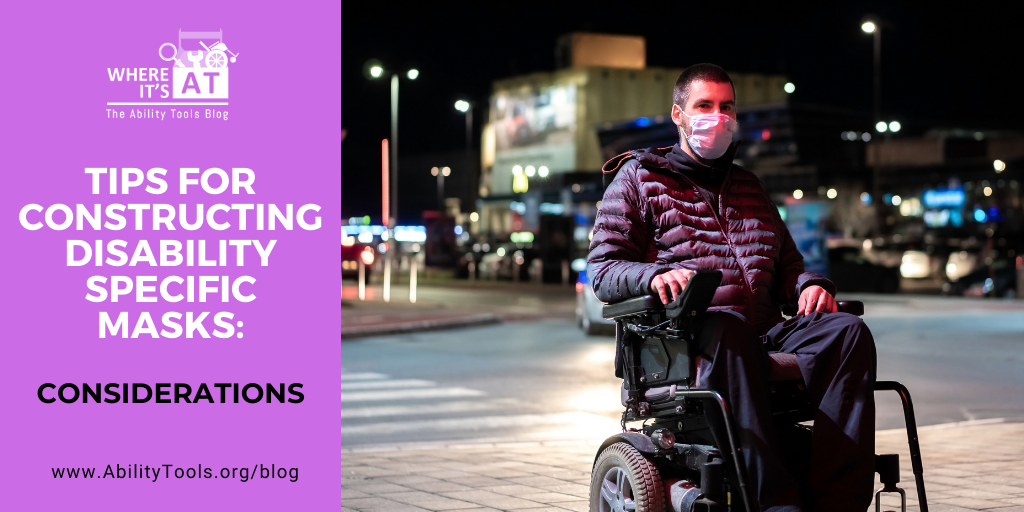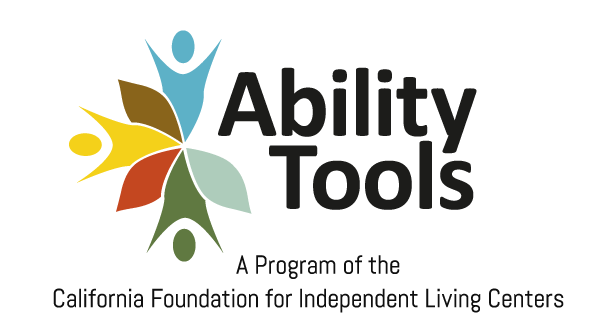Finding the right mask can be a challenge when you have specific needs. A good way to bypass all of the time and expense of trying masks by trial and error is to make your own.
In this blog, we will get into specific considerations one can take to customize their mask to suit their individual needs. For information on how to get started making your own disability specific face mask, including best material options and care instruction, please visit this blog’s companion: Tips for Constructing Disability Specific Masks: Getting Started

For People who utilize face-worn assistive technology
Use the largest patterns available or size up by increasing seam allowances to make the pattern larger.
See the Ability Tools video blog:
• No-Sew Facemask Tutorial for persons with face worn assistive technology
For People who have dexterity disabilities
Create loops on the ends of your straps that can be slid over your arm which you can then maneuver behind your head. This will allow you to hold the strap in position.
Utilize elastic bands to avoid tying straps. This also allows you to move the mask under your chin to eat or drink without taking the mask fully off and then reposition back to your face when needed.
Utilize Velcro at the end of you strap to easily secure them together.
Use extra-long straps to allow the tying of your mask alongside your face rather than in the back. This extra length can also be used to assist with positioning the mask on your face.
For People who are blind or have low vision
Use textured material, a fabric tab, or a button on the outside of your mask to identify the inside/outside.
*Always be sure to wash your hands after reapplying or touching the outside of your mask.
For People with breathing disabilities
When deciding how many layers to use, balance degrees of protection vs. breathability. You want enough layers to protect, but not smother.
Use larger patterns to allow for more breathing room in your mask.
For People with sensory disabilities
Choose natural fabrics for the layer that touches your face, such as:
• Bamboo muslin
• 100% cotton
• Soft wool
• Linen
• Pillowcases/sheets
If your fabric is stiff or coarse, wash it a couple of times with a gentle soap or baby fabric softener to soften the material.
Iron after washing to avoid irritation from wrinkles.
For People with Intellectual disabilities
If someone is making your mask for you, be sure to participate and let them know what features will be most helpful.
Prioritize comfort.
Personalize your mask by using materials which relate to your interests; try a favorite team, color, or movie.
Color/pattern code drawstring pairs or add tabs at the ends to make it easier to match when tying your mask.
More Resources
For a printable version of this blog in Tip Sheet form, please visit:
• Face Masks for All – Tips for Constructing Disability Specific Masks: Considerations
For additional information on how you can make the best face mask for your needs, please visit this blog’s companion printable tip sheet:
• Face Masks for All – Tips for Constructing Disability Specific Masks: Getting Started
See the Ability Tools video blog:
• No-Sew Facemask Tutorial for persons with face worn assistive technology
The preceding information was intended to increase overall safety awareness. It should not be considered expert advice, nor should it replace a professional consultation. Please reach out to CFILC with any suggestions or concerns.
This tip sheet was created in partnership with the State Council on Developmental Disabilities.




